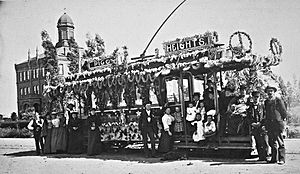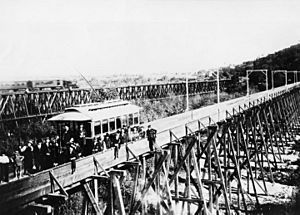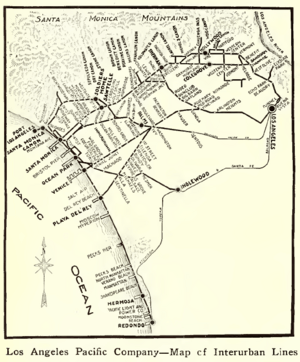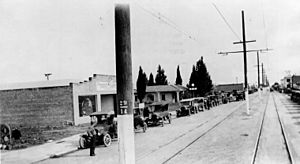Moses Sherman facts for kids
Quick facts for kids
Moses Hazeltine Sherman
|
|
|---|---|

He was also known as M. H. Sherman - General M. H. Sherman
|
|
| Born | December 3, 1853 West Rupert, Vermont
|
| Died | September 9, 1932 (aged 78) |
| Known for | Sherman Oaks, Los Angeles and Los Angeles Pacific Railroad |
Moses Hazeltine Sherman (born December 3, 1853 – died September 9, 1932) was an important American land developer. He helped build many streetcar systems. These included the Phoenix Street Railway in Phoenix, Arizona. He also built parts of the Los Angeles Railway and Pacific Electric Railway in Los Angeles, California.
Sherman also owned and developed land in many areas. These included the westside of Los Angeles, the San Fernando Valley, and Hollywood. He was also known as M. H. Sherman or General M. H. Sherman.
Contents
Early Life and Arizona Adventures
Moses Sherman was born in West Rupert, Vermont, on December 3, 1853. He became a teacher after studying at Oswego Normal School in Oswego, New York. He taught in New York and Wisconsin.
In 1874, he moved west to the Arizona Territory because he was not feeling well.
Starting Schools in Arizona
In Arizona, Sherman began teaching in Prescott. He created the first graded school system there. This meant students were grouped by age and learning level. He taught there from 1874 to 1876.
In 1876, a new two-story school opened with Sherman as its principal. He also represented Arizona at a big exhibition in Philadelphia.
Sherman's sister, Lucy, also a teacher, moved to Arizona with him. She later married Eli P. Clark, who became Sherman's close business partner.
Becoming "General" Sherman
In 1879, Sherman was made State Superintendent of Public Instruction for Arizona. In this role, he wrote the laws for the territory's schools. He also helped choose land that would support the future University of Arizona.
He earned the title "General" in 1883. This was after he was appointed Adjutant-General of the Arizona Territory. He used this title for the rest of his life.
During these years, Sherman also started investing in businesses. He bought property in Prescott and built a hotel called The Sherman House. He also invested in mines, cattle, and grazing lands. As Arizona grew, his businesses made a lot of money.
Developing Phoenix, Arizona
By the early 1880s, Sherman focused his efforts on the Salt River Valley and Phoenix. He invested in the Arizona Canal, a major irrigation canal. This canal helped bring water to farms in the valley.
In 1884, he helped start the Valley Bank of Phoenix and became its president. He also owned a lot of the Phoenix Water Company. Sherman bought large amounts of land around Phoenix. He became one of the biggest taxpayers in the area.
In 1887, he built a street railway in Phoenix. He later added electricity to the lines in 1893. This became the Phoenix Railway Company of Arizona. He controlled this company until 1925. He also built a line from Phoenix to Glendale in 1910.
Sherman also helped move the Arizona capital to Phoenix. He and his partner, M.E. Collins, donated 10 acres of land for the new capitol building in 1889.
Building Electric Rail in Los Angeles

Sherman visited Los Angeles many times while in Arizona. He believed the city had a bright future. He moved there in 1890. Soon after, he became a director at the National Bank of California. He and his brother-in-law, Eli Clark, quickly got involved in the transportation business.
The Los Angeles Consolidated Electric Railway
Before Sherman arrived, Los Angeles had various horse-drawn and cable car lines. Sherman saw the potential of new electric trolley technology. He bought several street railway companies. He then started building a system based on electric power.
In November 1890, Sherman and Clark started the Los Angeles Consolidated Electric Railway Company (LACE). Clark became the Vice President. Their goal was to build many electric railway lines. These lines would connect important parts of Los Angeles.
They built lines to areas like Pico Boulevard, Westlake Park, and Rosedale Cemetery. They also built lines to the University of Southern California and University Park. Other lines went to Highland Park, East Los Angeles (now Lincoln Park), and cemeteries.
LACE competed with an older cable railway, the Pacific Railway. LACE bought the cable company when it went out of business in 1892. By 1893, LACE operated 35 miles of electric lines.
In 1895, Sherman lost control of LACE due to financial issues. The company was renamed the Los Angeles Railway. It was later sold to Henry Huntington in 1898. This system became known as the famous "Yellow Car" system.
First Interurban Lines
Even while LACE was growing, Sherman and Clark began planning a larger rail network. In April 1894, they started the Pasadena and Los Angeles Electric Railway Company. This was Southern California's first electric railway connecting different cities. It linked Pasadena to the LACE system in Los Angeles in May 1895.
In November 1894, they formed another company, the Pasadena and Pacific Electric Railway Company. This company aimed to connect Los Angeles to Santa Monica. They bought existing railroads and rebuilt an old steam line. This line went from downtown Los Angeles to Santa Monica.
In 1896, Sherman bought land near Hollywood. He built storage yards and car barns for his streetcar line. He named this area Sherman. A town grew around this facility, which later became West Hollywood.
The Los Angeles Pacific Railroad
After losing control of LACE, Sherman and Clark focused on expanding lines to the beaches. In June 1898, they created a new company called The Los Angeles-Pacific Railroad. This company was later bought by Henry E. Huntington and became part of the Pacific Electric system.
Some people criticized Sherman's business methods. However, investigations showed that bank failures linked to him were due to other reasons.
Sherman and Clark built lines across the west side of Los Angeles. These lines went from Los Angeles to Hollywood, Santa Monica, and other beach cities like Venice, Manhattan Beach, and Redondo Beach.
Sometimes, property owners gave land for the railway lines. Other times, they paid money to have a line pass through their property. For example, people in Hollywood paid $15,000 for a line to be built there.
At its busiest, the Los Angeles Pacific had 180 miles of track. These tracks covered the western parts of Los Angeles County.
In March 1906, Sherman and Clark sold most of their railway to E. H. Harriman of the Southern Pacific. In 1910, they sold their remaining interest. In September 1911, these lines were combined with Huntington's Pacific Electric Railway. Sherman remained on the board of the Pacific Electric Railway.
Developing Real Estate in Los Angeles
Sherman was very good at using his electric railways to help sell land. His Los Angeles Pacific lines were key to developing communities between Los Angeles and the coast. The Balloon Route was a famous train excursion. It took tourists on a balloon-shaped trip to popular spots between Los Angeles and the ocean. This route helped show potential homebuyers the area.
In 1900, Sherman and his partners bought 1,500 acres in Hermosa Beach. Their company provided water, and they built the first boardwalk and pier. The community was later served by LAP's new car line.
In 1903, Sherman and Clark bought 200 acres north of Hermosa Beach. They named it Shakespeare Beach, hoping it would attract writers. Some street names there, like Homer Street, still show this original idea.
Sherman worked with many important businessmen on large projects. These included Harrison Gray Otis and Harry Chandler.
Hollywood and Playa del Rey
In 1900, the LAP built a line along Prospect Boulevard (now Hollywood Boulevard). In 1901, Sherman and Hobart J. Whitley formed a company. They bought and divided 480 acres in Hollywood. They called this the Hollywood Ocean Vista Tract. They built sidewalks and planted trees. They also donated land for a bank and the future Hollywood Hotel.
In 1902, Sherman and a group of fifteen men bought 1,000 acres near the Ballona lagoon. They renamed the area Playa del Rey. They built a large pavilion, a hotel, and a boathouse. Sherman and Clark's railway built a line to this new resort. Many visitors bought land and built homes along the beach.
In 1905, Sherman and Clark extended a line along San Vicente Boulevard. This line went through the Brentwood area, where Sherman had investments, and on to Santa Monica.
Later Real Estate Projects
In July 1905, Sherman and Clark bought 640 acres in Beachwood Canyon. In the early 1920s, they partnered with Harry Chandler and S.H. Woodruff. They developed this property and named it Hollywoodland.
They built a large, lighted sign to promote their development. This sign was completed in July 1923. After World War II, the sign was rebuilt, and the "land" part was removed. It now simply reads "Hollywood".
Chandler and Sherman were major investors in a group that bought the Tejon Ranch in 1911. This was a huge 270,000-acre ranch.
Sherman also invested in the Colorado River Land Company in 1906. This company owned a vast amount of land in Mexico. These investments helped the economy in northern Baja California.
He also acquired much property in Culver City.
Water and the San Fernando Valley
Sherman was appointed to the Board of Water Commissioners in 1903. He worked on the Owens River project. This project aimed to bring water to Los Angeles.
Los Angeles needed more water for its growing population. In 1904, engineers found a way to bring water from the Owens River to Los Angeles.
Around the same time, a group of investors bought land in the San Fernando Valley. This group included important people like Henry E. Huntington and Harry Chandler. Some rumors suggested Sherman shared information about the aqueduct project with his business friends. However, there was never any proof that this happened.
In 1909, a second group of investors bought a large part of the San Fernando Valley. This group included Sherman, Hobart Johnstone Whitley, Harrison Gray Otis, and Harry Chandler.
Sherman’s Los Angeles Pacific Railroad started planning a route to the Valley in 1909. By 1912, the Pacific Electric Railway completed a new line to the San Fernando Valley. This line helped connect the new developments to Hollywood.
The group also built a major road called Sherman Way. This road was very important for the success of the new developments. By 1912, people could travel from Van Nuys to downtown in 45 minutes by streetcar.
They created three communities: Van Nuys in 1911, Marion (now Reseda), and Owensmouth (now Canoga Park) in 1912. Sherman kept 1,000 acres of land around Ventura and Sepulveda Boulevards. This area later became the neighborhood of Sherman Oaks, named after him.
Sherman was removed from the Water Board in 1910. This was because a department related to the aqueduct leased space in a building he owned.
Other Activities
Sherman was a director in many companies. These included the Farmers & Merchants National Bank.
In 1903, Sherman helped start the Hueneme, Malibu and Port Los Angeles Railway. This railway was built to protect the Malibu Ranch from other railway projects.
After the 1906 San Francisco earthquake, Sherman organized a train of volunteers and medical supplies. It was the first train to reach San Francisco after the disaster.
After World War I, he saw a need for steamship service. He helped form the Los Angeles Steamship Company. Their ships sailed between Los Angeles, San Francisco, and Hawaii. The company was later sold in 1930.
Personal Life
Moses Sherman married Harriet Emily Pratt in 1885. They had two daughters, Hazeltine and Lucy. Sherman also adopted Harriet's son, Robert Pierce. Sherman and his wife divorced in 1908. He never remarried.
He lived in the Westminster Hotel for many years. Later, he moved to an apartment suite. He also had a house in Newport Beach, where he passed away on September 9, 1932.
Sherman left a large estate. He gave money to several colleges, including the University of Southern California and California Institute of Technology.
Legacy
Sherman Foundation and Library
Arnold D. Haskell, Sherman's close assistant, started the Sherman Foundation in 1951. It is located in Corona del Mar and has a garden and a research library. The Foundation has supported hospitals, youth groups, and scientific research.
Sherman Way
A major road built by the Suburban Homes Company was named "Sherman Way" in his honor. Part of this road still exists today in Canoga Park and West Hills. Another part is now Chandler Boulevard. Hazeltine Avenue, which runs north and south, was named after his daughter Hazeltine.
Sherman Oaks
The neighborhood of Sherman Oaks in Los Angeles is named after Moses Sherman. He owned 1,000 acres of land there.
Hollywoodland and the Hollywood Sign
Sherman was a key developer of the Hollywoodland area. The famous Hollywood Sign was originally built to promote this development.
Westside Communities
Sherman was important in developing many communities on the westside of Los Angeles. These include West Hollywood, Playa del Rey, and Hermosa Beach.






